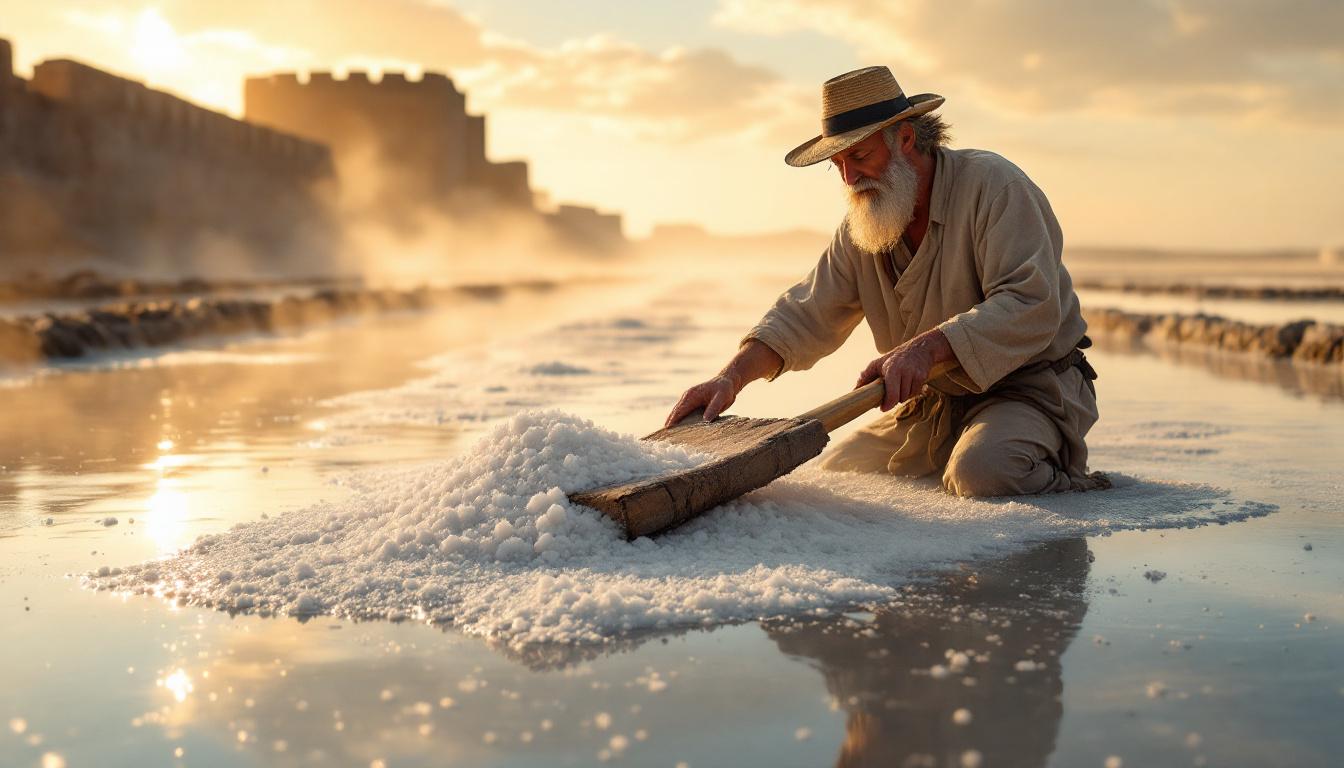In the medieval heart of western France, where salt-crusted marshes stretch beyond ancient ramparts, Guérande stands as the world’s only surviving town where paludiers still harvest “white gold” using 800-year-old techniques. While tourists flock to overcrowded Mont Saint-Michel, this fortified gem guards France’s last active salt-working tradition with fierce local pride.
This isn’t just another quaint French village—it’s a living museum where medieval salt workers called paludiers continue an unbroken chain of knowledge passed down through 30 generations. The sight of weathered hands wielding wooden lousse tools at dawn, skimming crystalline fleur de sel from mirror-still pans, exists nowhere else on Earth.
Local families who’ve worked these marshes since the 13th century now face their greatest challenge: protecting their heritage from tour buses that threaten to transform their sacred workplace into another commodified attraction.
The exclusive salt empire hidden behind medieval walls
France’s only living salt-working medieval town
While other French salt regions like Camargue rely on industrial machines, Guérande’s 2,000-hectare salt marshes remain hand-worked exactly as Benedictine monks designed them in 946 AD. The town’s PGI-protected fleur de sel commands premium prices precisely because no mechanical harvesting has ever touched these sacred pools.
The paludier families who guard ancient secrets
Only 80 active paludier families remain, each stewarding knowledge that took centuries to perfect. These salt workers recognize weather patterns their ancestors documented in medieval ledgers, timing harvests to the exact moment when Atlantic winds create the perfect crystalline crust that forms France’s most prized seasoning.
Ancient techniques that tour groups will never witness
The sacred ritual of fleur de sel harvesting
Before sunrise, paludiers wade into their œillets armed with traditional tools: the las for raking coarse salt and the delicate lousse à fleur for skimming the precious surface crystals. This morning ritual, performed only during specific wind and temperature combinations, produces just 40 kilograms per hectare annually.
Medieval infrastructure still channeling Atlantic tides
The intricate network of canals, called étiers and vasières, follows 11th-century engineering that captures Atlantic tides through the Traict du Croisic. This gravitational system requires no pumps or modern intervention—just the same stone-lined channels that medieval monks carved to create France’s salt empire.
Why locals actively discourage mass tourism
Protecting fragile ecosystems from tourist damage
Salt pans require absolute stillness to form proper crystals. Even footsteps can destroy a season’s harvest, which is why paludiers limit access to small guided groups and refuse to accommodate large tour buses that other French attractions eagerly court.
Preserving cultural authenticity over tourism revenue
The Le Guérandais cooperative deliberately restricts visitor numbers, choosing cultural preservation over profit. Local families have watched other regions lose their identity to tourism and refuse to let Guérande’s living heritage become a sanitized theme park experience.
The summer-only experience worth protecting
Peak harvesting season reveals medieval mastery
July through September offers the only opportunity to witness active salt harvesting, when hot summer winds create optimal conditions for fleur de sel formation. The Saillé observation point provides respectful viewing during afternoon harvests, but access requires advance booking through local guides who ensure minimal ecological impact.
Authentic encounters with working paludiers
Unlike performative demonstrations elsewhere, visitors can purchase freshly harvested salt directly from working paludiers at roadside stands throughout the marsh region. These interactions, conducted in French with proud explanations of family traditions, offer genuine cultural exchange impossible at commercialized attractions.
Guérande represents something increasingly rare: an authentic medieval town that chose cultural preservation over tourist dollars. The paludiers’ determination to maintain their 800-year tradition creates an irreplaceable window into France’s living heritage—one that may not survive another generation of tourism pressure.
For travelers seeking genuine cultural encounters, Loire Valley’s hidden château villages and France’s protected abbey communities offer similar authentic experiences. But nowhere else can you witness Europe’s last medieval craftsmen practicing techniques unchanged since the Middle Ages, making Guérande a treasure worth protecting through respectful, limited tourism.
Planning your authentic Guérande experience
When can I witness active salt harvesting?
Peak harvesting occurs July through early September during hot, windy afternoons. Morning visits offer the best chance to see paludiers at work, but weather conditions determine daily activities.
How do I access the salt marshes respectfully?
Only guided tours through local cooperatives provide marsh access. The Terre de Sel visitor center offers educational tours, while the Saillé observation point allows respectful viewing without disturbing active harvests.
What authentic salt products should I purchase?
Look for PGI-certified fleur de sel sold directly by paludiers at roadside stands or the Le Guérandais cooperative store. Avoid generic “Guérande salt” sold elsewhere, which often comes from industrial producers.
Why do locals limit tourist access?
Salt crystallization requires undisturbed conditions. Even vibrations from large groups can ruin harvests, while foot traffic damages delicate marsh ecosystems that took centuries to perfect.
How does Guérande compare to other French salt regions?
Unlike mechanized Camargue production, Guérande maintains hand-harvesting methods. Its medieval town setting and active cultural traditions make it unique among French salt-producing regions.
